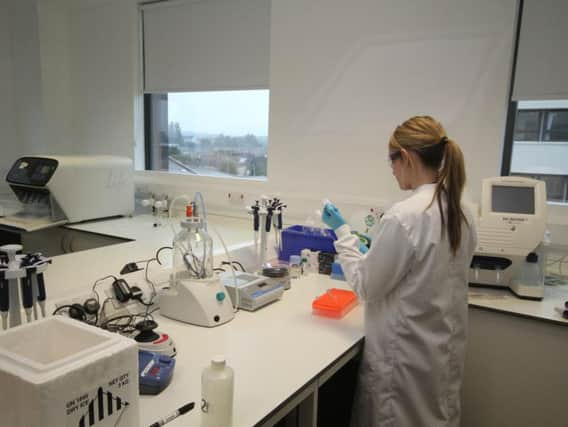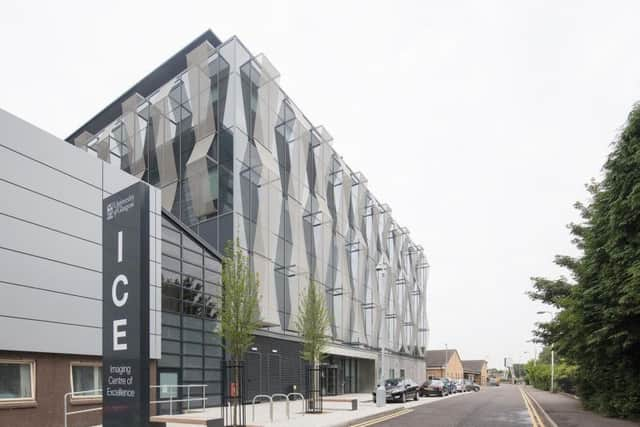Hunt for modern 'magic bullet' to offer pinpoint drug delivery


About 120 years ago German physician and scientist Paul Ehrlich was working on ways to tackle specific microbes that cause disease, without harming the human body.
He hoped to find what he called a “magic bullet”; in the case of his research, chemicals that could be injected into the blood, hunt down a germ and kill it.
Advertisement
Hide AdAdvertisement
Hide AdHis vision formed the building blocks for what would become chemotherapy and coined a phrase that would encapsulate the dream of finding the perfect cure.


The newly formed University of Glasgow Clinical Innovation Zone at the Queen Elizabeth University Hospital is a long way from the London lecture theatre of 1908 where Ehrlich spoke of his vision for a magic bullet.
Yet it’s here, in Scotland and more than a century later, that the groundwork for a very modern version of a magic bullet – one which could radically transform the way many patients are treated – is being developed.
In the shadow of Scotland’s new super hospital, the 1,677-bed, £1 billion Queen Elizabeth University Hospital, sparks – of the innovative kind – are flying.
Some of the brightest minds from academia, industry and healthcare are joining forces with the very latest technology.


Their focus is to position Scotland at the cutting edge of scientific discovery, to unravel the human genome in a way that can transform how we are treated in the future by eliminating the costly – in human and financial terms – chance element to the drugs we take, and improve our outcomes.
Dr Carol Clugston, chief operating officer of the College of Medical, Veterinary and Life Sciences at Glasgow University, explains.
“Generally speaking only 25 per cent of medicine is effective for people that it’s given to. Which means 75 per of medicines don’t work effectively.
Advertisement
Hide AdAdvertisement
Hide Ad“When I first heard that, I thought ‘Wow’,” she admits. “That is a huge number and it’s got a lot of implications.”
In many cases GPs are left with a trial-and-error approach to prescribing drugs.
“They’ll tweak the dose, try something different until they get the right fit for an individual patient’s need.
“That’s fine for something like high blood pressure,” concedes Clugston.
“But if you have cancer and it’s aggressive, you don’t have the luxury of time to wait to try different medicines.”
The application of precision – or stratified – medicine would enable doctors and consultants to prescribe for the individual at the outset, taking away the risk element, cutting the drugs bill and resulting in better outcomes.
“In the future, a patient would be able to get some sample tests done before being given a drug,” adds Clugston.
“Their gene is sequenced, and that scientific information will be used to make a decision about what treatment they get. There’s a lot more certainty about how that drug will work.
Advertisement
Hide AdAdvertisement
Hide Ad“This will be transformational for patients. And there’s a race going on as to who can get there first.”
That is where the Stratified Medicine Scotland Innovation Centre (SMS-IC) and the nearby Imaging Centre of Excellence (ICE) come in. As the cost of DNA sequencing technology has decreased and expertise surrounding the kind of big data that’s involved in unravelling what drugs might work best for which individual has progressed, the climate is right for this innovative approach to personalised medicine.
And it is one which could bring major benefits to the NHS by cutting costs and making it more efficient, as well as improving the nation’s health.
The SMS-IC, led by Glasgow University but with a Scotland-wide remit, was formed by the Scottish Funding Council in 2013 with an initial investment of £8 million, followed in 2016 with £4m funding to develop the Scottish Precision Medicine Ecosystem.
At its core is a consortium of partners from four Scottish NHS health boards – Greater Glasgow and Clyde, Lothian, Grampian and Tayside – the universities of Glasgow, Edinburgh, Aberdeen and Dundee, and two industry partners, informatics specialists Aridhia and ThermoFisher Scientific.
ThermoFisher’s role has been to resource the centre with the ability to carry out DNA sequencing, providing equipment worth £3.5m.
Aridhia, meanwhile, crunches the data – a huge but delicate task when dealing with patients’ confidential information.
It is far from a closed shop. For example, smaller Scottish companies have been working hand in hand with SMS-IC’s partners on developing diagnostic tools and tests that will bring the vision together. “Our philosophy is very much that one single partner won’t just make this happen,” says Clugston.
Advertisement
Hide AdAdvertisement
Hide Ad“But when you combine all the people across Scotland working together – universities, NHS and industry coming together – we accelerate the benefits for everyone.”
Where SMS-IC really comes into its own, is its location in the Clinical Innovation Zone at the very beating heart of Scotland’s biggest and newest hospital, with patients, clinical academics, leading consultants and new facilities for clinical trials a stone’s throw away.
Scotland itself plays its part, with a well organised and integrated NHS, a stable population with, unfortunately, a host of chronic health conditions, existing good electronic records and data to build on.
There’s another key factor in this mix, one which is capable of bringing even greater benefits and has already positioned Glasgow as a destination for life science innovation and skill.
It comes in the form of the UK’s first ultra-high field 7 Tesla (7T) MRI scanner to be fully integrated in a clinical setting, a £10m piece of highly advanced kit that can be used for clinical research and advancing the understanding of disease.
In the £32m ICE, funded partly by Glasgow City Deal, the 7T’s usefulness in subdividing and stratifying patients feeds directly into the work being done on precision medicine.
It has attracted some of the brightest minds to the Clinical Innovation Zone, among them leaders in their field from Germany, California and Singapore.
“This scanner is the first on a hospital site where it can be used for patients – the others in the UK are being used in research into understanding the brain as opposed to looking at disease,” Clugston says.
Advertisement
Hide AdAdvertisement
Hide Ad“It is incredibly advanced, we had to recruit internationally for specialist staff to join us.”
The recruits include a German academic who helps develop MR coils, a key part of the scanner, and who has brought his company to Glasgow where he plans to recruit people.
Recently California-based cancer diagnostic specialist BioClavis opted to locate to the Clinical Innovation Zone, creating jobs in the area.
Economic assessments suggest that ICE alone should produce about 400 new jobs for Glasgow over the coming five years, while Glasgow University has been given the go-ahead to carry out a major Business, Energy & Industrial Strategy audit to gauge the multiple benefits precision medicine is likely to bring.
“The ICE building was constructed for collaboration,” says Clugston, highlighting how glass walls and open space is a vital element in helping pave the way for collaboration.
“You allow academics, clinicians, engineers and health professionals to rub shoulders with the people from companies that are interested in innovations in health – it creates the kind of spark that, without this investment, could never have happened,” she says.
The potential is huge – from the economic benefits to the health improvements precision medicine could bring, as well as the potential savings and efficiency impact on the NHS.
So when might we start seeing results?
“We start where we think we can make the biggest progress,” says Clugston.
Advertisement
Hide AdAdvertisement
Hide Ad“Pancreatic cancer and rheumatoid arthritis are led by Glasgow clinical academics that are incredibly strong. Multiple sclerosis is led by Edinburgh.
“But,” she adds, “patients will benefit very soon.”